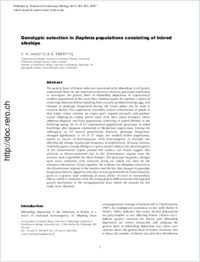Genotypic selection in Daphnia populations consisting of inbred sibships
- Haag, Christoph R. Département de Biologie, Université de Fribourg, Switzerland - Tvärminne Zoological Station, Hanko, Finland - Institute of Evolutionary Biology, University of Edinburgh, UK
- Hebert, Dieter Zoologisches Institut, Universität Basel, Basel, Switzerland - Département de Biologie, Université de Fribourg, Switzerland - Tvärminne Zoological Station, Hanko, Finland
-
25.04.2007
Published in:
- Journal of Evolutionary Biology. - 2007, vol. 20, no. 3, p. 881–891
English
The genetic basis of fitness reduction associated with inbreeding is still poorly understood. Here we use associations between allozyme genotypes and fitness to investigate the genetic basis of inbreeding depression in experimental outdoor populations of the water flea, Daphnia magna. In Daphnia, a phase of clonal reproduction follows hatching from sexually produced resting eggs, and changes in genotype frequencies during the clonal phase can be used to estimate fitness. Our experiment resembles natural colonization of ponds in that single clones colonize an empty pool, expand asexually and produce sexual offspring by selfing (sisters mate with their clonal brothers). These offspring diapause and form populations consisting of selfed sibships in the following spring. In 12 of 13 experimental populations, genotypes of selfed hatchlings after diapause conformed to Mendelian expectations. During the subsequent ca. 10 asexual generations, however, genotype frequencies changed significantly at 19 of 27 single loci studied within populations, mostly in favour of heterozygotes, with heterozygosity at multiple loci affecting the change in genotype frequency multiplicatively. Because variance in heterozygosity among siblings at a given marker reflects only heterozygosity in the chromosomal region around this marker, our results suggest that selection at fitness-associated loci in the chromosomal regions near the markers were responsible for these changes. The genotype frequency changes were more consistent with selection acting on linked loci than on the allozymes themselves. Taken together, the evidence for abundant selection in the chromosomal regions of the markers and the fact that changes in genotype frequencies became apparent only after several generations of clonal selection, point to a genetic load consisting of many alleles of small or intermediate effects, which is consistent with the strong genetic differentiation and repeated genetic bottlenecks in the metapopulation from which the animals for this study were obtained.
- Faculty
- Faculté des sciences et de médecine
- Department
- Département de Biologie
- Language
-
- English
- Classification
- Biological sciences
- License
-
License undefined
- Identifiers
-
- RERO DOC 8086
- DOI 10.1111/j.1420-9101.2007.01313.x
- Persistent URL
- https://folia.unifr.ch/unifr/documents/300305
Statistics
Document views: 226
File downloads:
- pdf: 231
